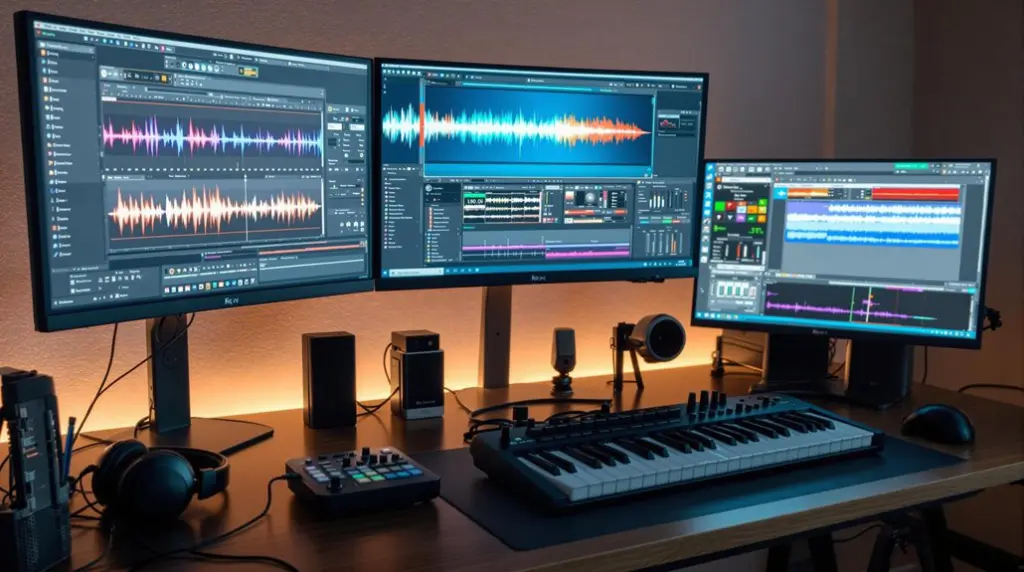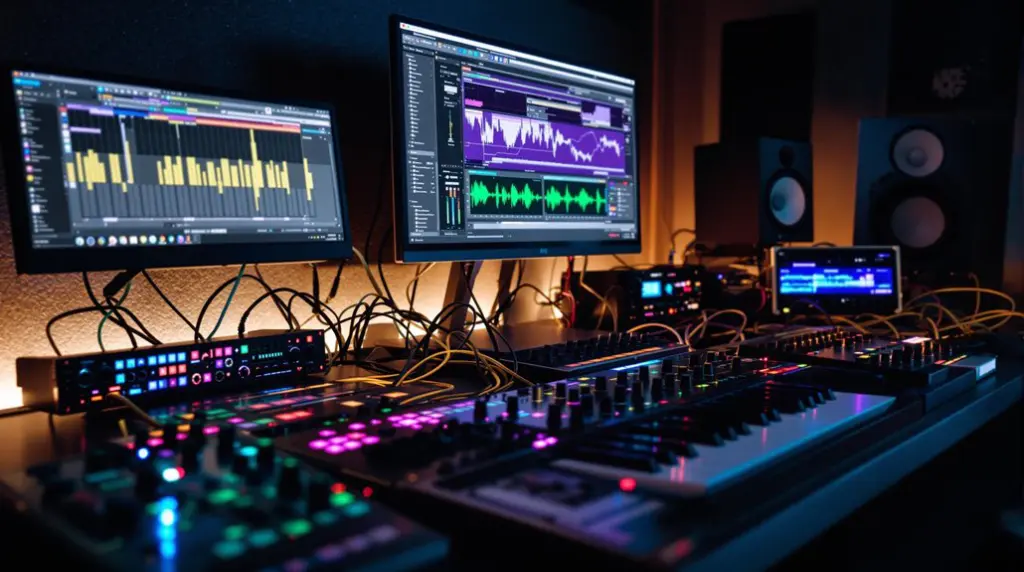Native Instruments Maschine VST is lauded for its impeccable integration with Maschine 2 software and robust hardware features, including dual high-resolution screens and extensive connectivity options like three MIDI outputs. It’s designed for enhanced workflow, featuring tag-based browsing, color-coded metering, independent loop range settings, and seamless live performance capabilities with support for unlimited groups. Advanced sampling, side-chaining, and low audio latency bolster its performance appeal. However, its larger size may affect portability. The Maschine Studio and Maschine+ models cater to different production needs with the latter supporting standalone operation. Explore further to understand its nuanced strengths and limitations.
Key Takeaways
- Dual high-resolution screens enhance workflow by enabling simultaneous viewing and editing.
- Maschine Studio supports tag-based browsing for quick sound library navigation.
- Three MIDI outputs, one MIDI input, and USB hosting expand external gear connectivity.
- Integrated side-chaining and advanced sampling engine offer enhanced real-time sound control.
- Built-in audio interface delivers high-quality 96 kHz / 24-bit sound with low latency under 6ms.
Maschine Studio Overview
In the domain of music production, the Maschine Studio stands as Native Instruments‘ flagship controller, engineered for deep integration with the Maschine 2 software. The controller features two high-resolution screens, notably enhancing workflow and navigation. These displays provide clear, detailed visual feedback, vital for intricate studio work.
The Maschine Studio’s design is refined for studio environments rather than live performances, evident from its substantial size and weight. The controller is 60% larger and 50% heavier than its predecessor, the Maschine MkII. This expanded footprint accommodates 19 additional buttons and a jog wheel, affording users more tactile control over their music production processes, similar to how DJ software tools like VirtualDJ offer real-time performance feedback to improve user experience.
Connectivity is another highlight of the Maschine Studio’s controller features. It includes three MIDI outputs and one MIDI input, alongside two footswitch connections, allowing for extensive peripheral integration. This connectivity suite guarantees that producers can link multiple devices seamlessly, enhancing the overall production capability.
Maschine Studio is built with a stand that angles the screens for ideal visibility, reinforcing its studio-centric design. This ergonomic feature guarantees that producers can comfortably engage with the controller during extended sessions.
The inclusion of the all-encompassing Maschine 2 software, with over 8GB of sounds, underscores its utility as a robust tool for music production.
Enhanced Workflow Experience
A notable enhancement to the workflow experience with Maschine Studio is attributed to its dual high-resolution screens, which offer a simultaneous view of workflow and details. This feature eliminates the need for constant switching to a computer, thereby greatly improving user experience and editing efficiency.
Users can navigate and edit seamlessly directly on the device, leveraging pads, buttons, and knobs to maintain a steady performance flow. Furthermore, the tag-based browsing feature, akin to DJ library organization techniques, streamlines sound library navigation, allowing users to locate specific sounds quickly and efficiently.
Additionally, the Maschine 2 software introduces tag-based browsing, which considerably streamlines sound library navigation. This allows users to locate specific sounds quickly, further enhancing the overall workflow.
The ability to adjust independent loop range settings provides greater flexibility in arranging music, enabling users to manage different sections of their compositions with ease. Visual feedback through color-coded metering also plays a vital role in the enhanced workflow experience.
This feature allows users to track sounds more effectively, offering clearer insights into audio levels and the overall mix during production. By integrating these features, Native Instruments has successfully optimized the user experience, making the editing process more efficient and intuitive for both novice and experienced producers.
Software and Live Performance
Although the Maschine 2 software comes equipped with a revitalized audio engine, it is the integration of features such as unlimited groups and tag-based browsing that truly improve live performance capabilities. The seamless workflow offered by these features facilitates efficient organization, allowing performers to access and manipulate sounds swiftly, thereby fostering live creativity.
Integrated side-chaining and an improved sampling engine, with extended sample length, provide advanced audio manipulation tools vital for real-time sound control. These enhancements are essential in maintaining dynamic performance dynamics, enabling artists to adapt and innovate during live sets.
Notably, the rise of portable mixers has also contributed to the flexibility and adaptability of live setups, allowing for diverse performance environments. Additionally, the ability of Maschine to function as a VST plug-in within Ableton Live, complemented by a dedicated controller template, greatly boosts functionality.
This integration allows for streamlined tempo adjustments, track selection, mixing, and effects management, which are integral to live performance fluidity. The dual high-resolution screens offer performers the advantage of viewing and editing workflow details simultaneously, minimizing the need to revert to a computer mid-performance.
Further enhancing the live experience, the jog wheel and 16-segment LED bargraph meter enable quick navigation through extensive sample libraries and real-time audio monitoring. Overall, these features collectively raise live performance dynamics and creativity.
Connectivity and Control
Maschine Studio and Maschine+ stand out in the domain of music production hardware due to their extensive connectivity and control options.
These devices are meticulously designed to offer seamless MIDI integration and hands-free control, thereby enhancing the workflow of music producers and live performers alike. Additionally, mastering tools like EQ and compression can be effectively utilized within these setups to further refine audio quality during production.
- MIDI Outputs and Inputs: Maschine Studio is equipped with three MIDI outputs and one MIDI input, greatly expanding its connectivity options. This allows for robust integration with a wide array of external gear, facilitating complex setups.
- Versatile Rear Panels: The rear panel of Maschine+ includes line outputs, mic/line inputs, and USB A ports. Such versatile connections enable expanded MIDI device support and offer greater flexibility in various production environments.
- USB MIDI Hosting: Both Maschine Studio and Maschine+ support USB MIDI hosting, making it possible to integrate seamlessly with multiple MIDI instruments and controllers. This feature guarantees a smooth and efficient workflow by enabling direct connections without additional interfaces.
- Hands-Free Control: Maschine Studio features two footswitch connections, permitting hands-free control. This functionality is particularly beneficial during live performances, allowing users to manage essential functions without interrupting their flow.
The inclusion of a central 16-segment LED bargraph meter on Maschine Studio further enhances control by providing visual monitoring of audio channels, essential during mixing and performance.
Pros and Cons
When evaluating the Native Instruments Maschine Studio and Maschine+, several pros and cons become evident, reflecting their strengths and limitations.
On the positive side, Maschine Studio offers seamless integration with Maschine 2 software, greatly enhancing the user experience through a revitalized audio engine and the ability to manage unlimited groups. This feature provides substantial flexibility in music production. Additionally, the device’s dual high-resolution screens support an efficient workflow, enabling users to edit and view multiple elements without reverting to a computer.
Users can also benefit from in-depth tutorials available on various music production blogs, which can help them master the Maschine Studio’s features more effectively.
However, there are notable drawbacks that could affect the user experience. One major concern is project migration; users shifting from previous versions may face issues when importing old projects, which can be frustrating and time-consuming.
Moreover, the larger size of Maschine Studio, while beneficial for studio use, limits its portability, making it less ideal for live performances compared to more compact models like Mikro.
Another usability issue arises with the limited visibility of longer instrument names on the display, complicating complex sessions and necessitating user-defined macros for managing intricate plug-in chains. These limitations highlight areas where Native Instruments could improve to enhance overall user satisfaction.
Maschine+ Design Features
The design features of the Maschine+ exhibit a thoughtful blend of functionality and portability, making it a compelling choice for modern music producers. As a standalone version of the Maschine MkIII, Maschine+ integrates an embedded processor and storage, enabling seamless operation without a computer. This feature considerably enhances its appeal for portable production, allowing artists to create music on the go.
Additionally, the durability and portability of Maschine+ make it comparable to some of the most rugged studio monitors available today.
Key design highlights include:
- Durability and Portability: Weighing approximately 2.5 kg and constructed with robust aluminum panels, Maschine+ is built to withstand the rigors of mobile music production while remaining lightweight and easy to transport.
- Expandable Storage: The inclusion of an SD slot for user content offers expandable storage, ensuring that producers have easy access to their samples and loops, thereby facilitating a more streamlined workflow.
- User-Friendly Interface: Upgraded touch-sensitive encoders, which are larger and feature a damped action, enhance user interaction, making the device more intuitive and responsive.
- Versatile Connectivity: The rear panel connections, including line outputs, mic/line inputs, and USB A ports, provide extensive integration options with external devices, ensuring versatile connectivity for diverse production setups.
Maschine+ effectively combines robust design with a user-friendly interface, catering to the needs of contemporary music producers seeking flexibility and ease of use.
Audio and Performance
Building on the robust design features, the audio and performance capabilities of the Maschine+ further solidify its position as a premier tool for music production. The revitalized audio engine of Maschine Studio considerably enhances overall performance, offering support for unlimited groups and tag-based browsing, which streamlines workflow and organization. The built-in audio interface, delivering 96 kHz / 24-bit quality, guarantees superior sound quality with multiple TRS line outputs and inputs, facilitating high-quality audio recording and playback.
The performance aspect is further accentuated by the system’s ability to manage numerous tracks, instruments, and effects until resource limits are reached. Although CPU spikes may occur with the use of premium plugins and complex effects chains, the audio latency remains impressively low, under 6ms, mirroring low buffer settings on computers. This guarantees a highly responsive experience, essential for both studio and live environments. The jog wheel enhances real-time manipulation of sound and effects, providing efficient navigation through extensive sample libraries.
| Feature | Description |
|---|---|
| Audio Engine | Revitalized, supports unlimited groups |
| Audio Interface | 96 kHz / 24-bit quality, multiple TRS ports |
| Audio Latency | Under 6ms |
| Real-Time Manipulation | Jog wheel for quick navigation and effects |
These attributes collectively amplify the Maschine+’s functionality, making it a top choice for professional music producers.
User Content Management
Diving into user content management with Maschine+, one quickly appreciates the flexibility it offers for importing and organizing custom samples and patches. The inclusion of a 64GB SD card, expandable for additional storage, guarantees ample space for extensive libraries.
However, the process is not without its complexities, especially when it comes to maintaining an effective sample organization. Proper installation of acoustic panels can also enhance the listening experience in your studio setup.
Key aspects to take into account include:
- Sample Importing: Maschine+ supports importing user samples and NKS-format patches, enhancing customization possibilities.
- Folder Structure: Effective sample organization hinges on maintaining the correct folder structure, imperative for seamless content integration.
- Content Navigation: While the SD card allows for adding raw samples and loops via the User Content folder, the absence of a generic file manager necessitates manual drag-and-drop operations.
- Library Limitations: Although unencrypted Kontakt libraries and Reaktor patches can be imported, most commercial libraries remain inaccessible due to encryption.
Users must navigate these elements carefully to optimize their workflow. The presentation of folders as Banks in One-Shots and Loops categories, while practical, may limit accessibility and require a thoughtful approach to folder structure.
Despite these limitations, Maschine+ provides a robust platform for managing a diverse array of samples and patches.
Integration and Connectivity
Understanding user content management within Maschine+ lays a solid foundation for exploring the device’s integration and connectivity capabilities.
The extensive MIDI integration offered by Maschine Studio, with its three MIDI outputs and one MIDI input, considerably enhances its connectivity potential with various MIDI devices and external gear. This expanded MIDI capability allows users to seamlessly incorporate external MIDI synths and instruments into their setup, fostering a versatile and dynamic production environment.
The inclusion of two footswitch connections on Maschine Studio offers hands-free control options, which are particularly beneficial during live performances.
The rear panel of Maschine+ is thoughtfully designed, featuring stereo audio I/O and dedicated MIDI ports. These ports facilitate smooth integration with external MIDI devices, guaranteeing a cohesive workflow.
Additionally, the USB 2.0 connectivity provided by Maschine ensures rapid data transfer between the controller and the computer, which is essential for maintaining an efficient production process.
Moreover, the inclusion of two footswitch connections on Maschine Studio offers hands-free control options, which are particularly beneficial during live performances. This feature enhances the user’s ability to manage the device without interrupting their creative flow.
Frequently Asked Questions
What Is MASCHINE Best For?
MASCHINE excels in beat production and live performance, offering a thorough environment for music creation. Its 16 ultra-sensitive pads, extensive sound library, and seamless software integration make it indispensable for diverse genres and spontaneous creativity.
Do Professionals Use Native Instruments?
Yes, professionals extensively use Native Instruments due to their innovative technology and consistent updates. According to professional opinions and industry trends, their robust integration, workflow enhancements, and high-quality audio resources make them a staple in music production.
What Are the Cons of Maschine+?
The cons of Maschine+ include its cumbersome content management, limited plugin control, lack of an internal power source, and potential stability issues with Reaktor instruments. These Maschine limitations suggest considering Maschine alternatives for more advanced and reliable performance.
Can You Use MASCHINE as a Vst?
Yes, MASCHINE can be used as a VST, allowing for seamless workflow integration within DAWs. Its VST integration facilitates efficient tempo management, track selection, and effect application, greatly enhancing the overall Maschine workflow for producers.
Conclusion
The review of Native Instruments Maschine VST highlights its thorough capabilities. The enhanced workflow experience, robust software features for live performance, and extensive connectivity options underscore its versatility. Key design elements of Maschine+ contribute to its superior audio performance and user content management. While the integration and control aspects are commendable, a balanced view of the pros and cons reveals areas for potential improvement. Overall, Maschine VST stands out as a powerful tool for music production.




